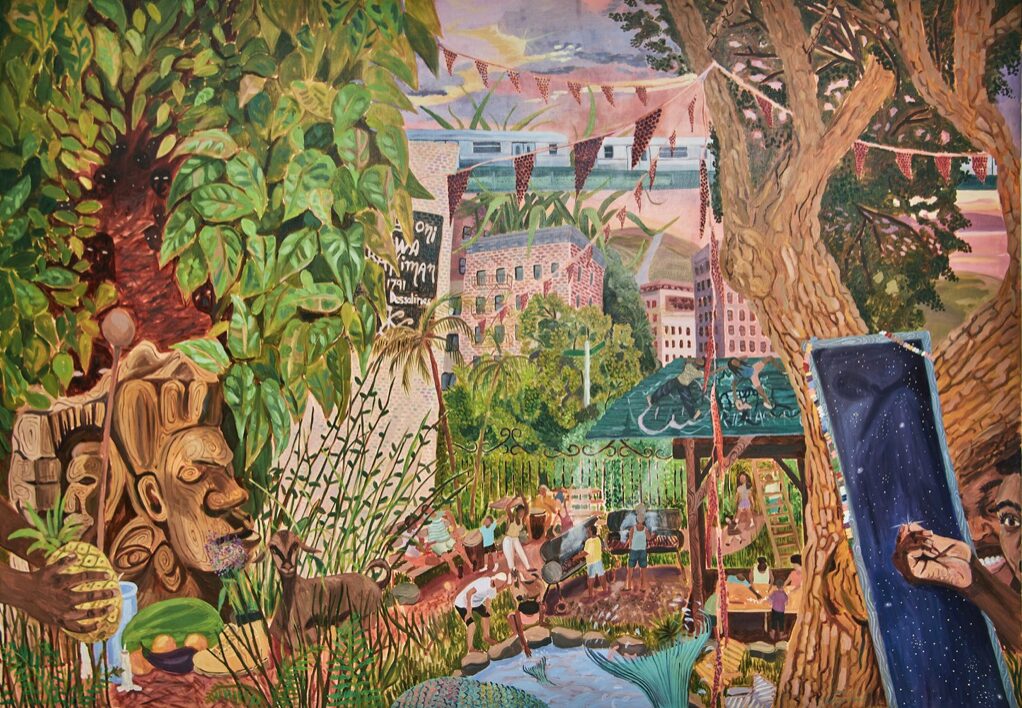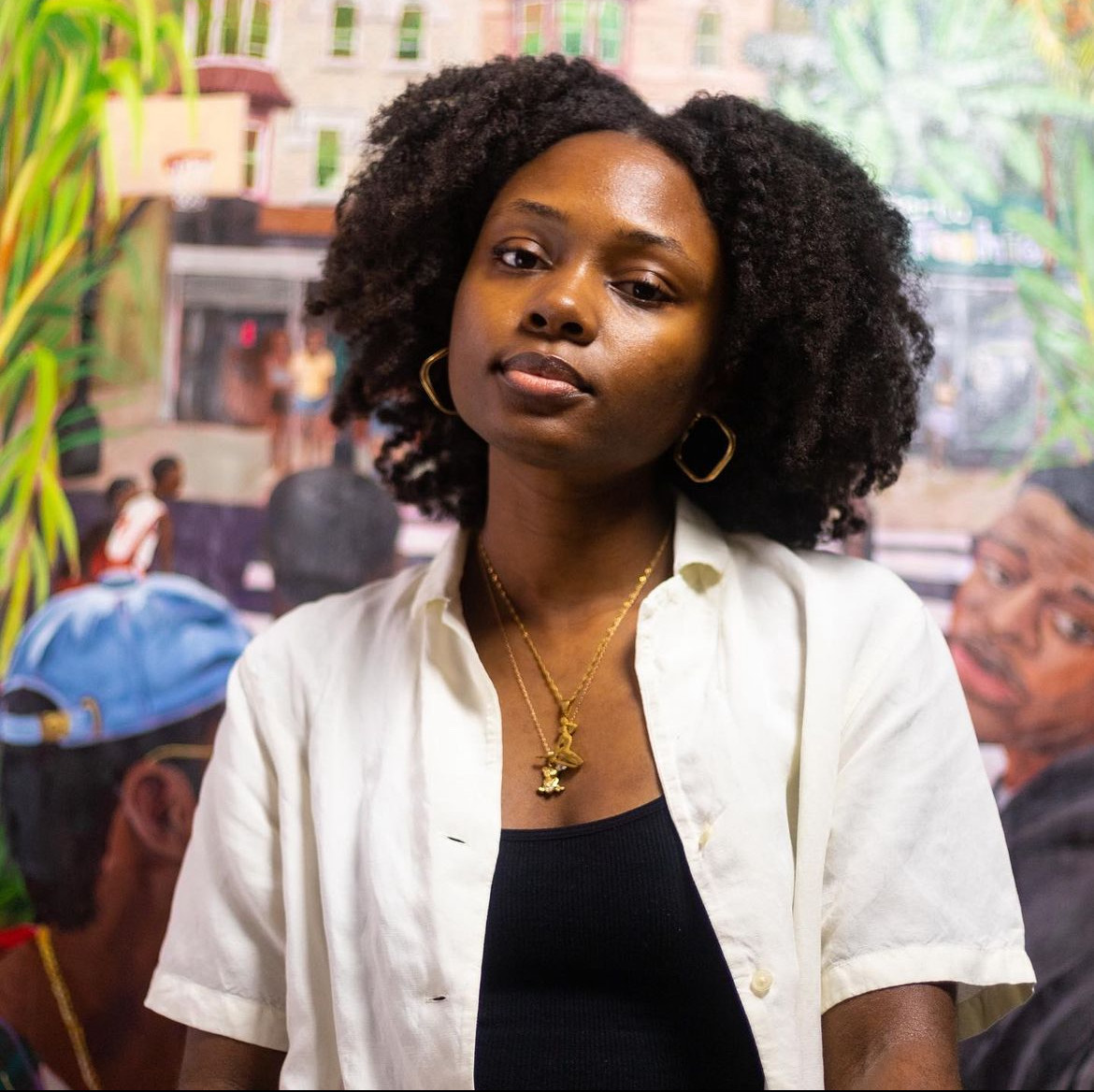
Courtesy of Madjeen Isaac

Courtesy of Madjeen Isaac
Can you imagine the lush rain forests of Haiti sprouting up across the buildings of New York City? Madjeen Isaac, a Brooklyn-based artist, is a painter and sculptor who incorporates her Haitian roots in her depictions of her city. Isaac’s style employs magical realism to warp landscapes and reimagine plant pots with human faces. Her focus is on centering black people and immigrants in moments of leisure and liberation to challenge the constraints of reality. She says she wants her work to, “…capture the essence of what I see on a day-to-day basis and reimagine it in worlds that can emulate what abundance looks like to me.”

Isaac is currently an artist at Brooklyn’s non-profit arts organization Smack Mellon, which is located near the Manhattan Bridge. This organization supports under recognized women artists by providing them with exhibition opportunities, studio workspaces, and equipment access for projects. She has also worked with Grown In Haiti, an environmental program that fosters sustainable communities and ecological stewardship through education and agroforestry and strives to educate future generations to transform landscapes to create a self-sufficient Haiti.
Having grown up in a Caribbean neighborhood, Isaac has advocated for environmental justice, food equity, and land sustainability. Her artwork supports those endeavors as the topics she visualizes often include scenes of urban gardens and lush plant life sprouting out of concrete structures. Although her work speaks for itself, you can learn more about her process and inspiration by listening to my conversation with her above.
Transcript below:
Oscar Nzekwu: Representing GW, Planet Forward, my name is Oscar Nzekwu and welcome to the next episode of Art-vironment, where we honor black artists who contribute in spreading environmental awareness through their artistic disciplines. Today, I met with an artist who uses her painting and sculptures to challenge the constraints of reality. Now introducing, Madjeen Isaac!
So for people who might not know about you, can you please introduce yourself and tell everybody about the art that you do?
Madjeen Isaac: My name is Madjeen Isaac and I was born and raised in Brooklyn, New York. I grew up in Flatbush and it’s a neighborhood that is predominantly Caribbean immigrants and Christians. And I grew up in a Haitian household.
A lot of my work is about me reimagining and recreating worlds where I merge both urban and tropical landscapes. I love highlighting my upbringing and cultural identity.
ON: I’m also aware you do sculpture. So do you also capture that through your sculptures too?
MI: Yeah, my sculptures are interesting to me. Right now for sculpture, I do work in clay and they’re like these planters that kind of resemble heads. I call them ancestors. And I’ve been, you know, playing around with the idea of like, creating my own space. Creating altars – just a space that feels really good to me and thinking a lot about spirituality and how I grew up with my Caribbean-Catholic household. Finding my own definition of what that means for me.
ON: Do you consider yourself as an environmental activist?
MI: Funny that you asked, because I recently have been thinking about this, like whether I’m an environmentalist or not. I don’t know if it’s appropriate to claim the title, but I think about it very, very often. In my works I highlight, or I like to think about disparities within my communities, where it could either be housing disparities or displacement, little to no access to green spaces, or just safe spaces for leisure or rest. Yeah, just thinking how a lot of our relationships to the environment- like how many alternatives we have, how much say do we have, how we can exist.
Yeah, I just get kind of sad when I see developments taking over in my community or even vacant lots just existing for quite some time and nothing is being done with it. I feel like there’s a sense of pride but also defeat that exists within my community and I would love for there to be more conversation about how we can get involved. There are a lot of community gardens that exist and I do volunteer at community gardens, which feels really rewarding for me. And I think one of my goals is to find out ways in which I can galvanize more people to be in those places, especially immigrants who have a background in either farming or growing their own herbs.
ON: In your artwork, how do images appear in your work, like images of nature?
MI: So I usually have greenery overgrowing and just existing on top of buildings in a way that is very obnoxious, but also very beautiful. I’m looking at my works now as I share. There’s just so much green happening and I think there’s also people tending to the farm and existing. Right now I’ve actually been exploring ancestors. I give ancestors existing in spaces no matter how far we migrate or where we are in the world. And so I’ve been playing a lot around with celestial beings and greenery or celestial beings carrying around herbs and foods that haven’t always been present in generations. Yeah, I’m just thinking about our relationship to medicinal foods and concoctions of herbs for healing.
ON: How does magical realism play a role in your art?
MI: Magical realism is something that I’m often that folks are drawn to within my works. And I’m often reimagining as a tool, creating hybrids. And a lot of my process involves deconstructing and reconstructing images. And so I think I’m often putting things together that don’t necessarily make sense. But it makes sense to me because it’s kind of like a conceptual idea of what I’ve always been around growing up and what I wish to see.
And I think that, you know, it gives folks the opportunity to also dream. So I feel like dreaming can be a luxury. We don’t always have the time to be able to dream. But I would hope that my works can hold space for that. Yeah like just- what are ways in which we find remedy through trusting our imagination for better realities and futures.
ON: Going back to New York City, what do you think is the biggest environmental issue that New York City faces?
MI: I feel like there’s two. Which is displacement due to housing insecurities. There’s a lot of new development here because old structures have been either broken down to then build new ones, but they’re also high in cost and no one can afford it. So a lot of development that’s out there, especially in the downtown area, is literally- They’re up but they’re empty, which is unfortunate. I guess our relationship to green spaces- I know there’s Prospect Park, there’s also other parks that exist throughout, but I think that there could be more green spaces that we can tend to and just insist on having access to. And that can also just be lawns that are in front of fewer buildings. I feel like those can be put to better use – or even rooftops.
ON: What’s the environmental message that you want people to take away form your art?
MI: Yeah, I want people to lean into what feels right to them, to claim their right to a better reality. And that could either mean more rest, leisure, maybe leaning into your ancestral practices of agriculture. And I think just, I want people to really understand what their roles can be within their environments or communities. I feel like we’re all experts in something and we can all learn from each other.
ON: When people have seen your work, have (they) become more active in trying to speak up?
MI: That’s a really good question. I think that- I feel like my works exist as beautiful archives of what could be. They can also be blueprints for these types of conservations and actions. I don’t think that my painting is just enough to create change. I think that I can utilize them to do that, whether that be through ongoing workshops or to galvanize people to join me in- whether it’s volunteering at community gardens and just in those spaces or creating your own garden. I think that there’s so much more that I can do. Painting is definitely a first step, but then actualizing it and putting into practice is also another.
ON: For future artists, what advice would you give them if they want to attack or address environmental issue or get active in environmental activism?
MI: Starting where you are and seeing what’s available to you. Maybe thinking about what you’re struggling with or what your community is struggling with. You have to start as well. But it’s always just like- start where from where you are. And normally you have to look far, but I’m pretty sure that there’s always just something within your vicinity that is happening that you can like, shed some light on just tend to.
ON: Excellent, excellent. Thank you for letting me interview you! You are amazing, my god!
MI: Cool! This was great! Thank you for holding space.
ON: From the wise words of Madjeen, make sure you understand what your roles can be within the environment to claim your right for a better reality. I would like to thank Madjeen for letting me interview her to explore how her magical realism plays a role in the environment. And if you want to learn more about Madjeen and her work, follow her on Instagram at madjeenisaac.
Thank you for tunning in to my episode of ArtVironment. Remember, stay green on the scene. This is Planet Forward. Oscar Nzekwu signing off. Peace!